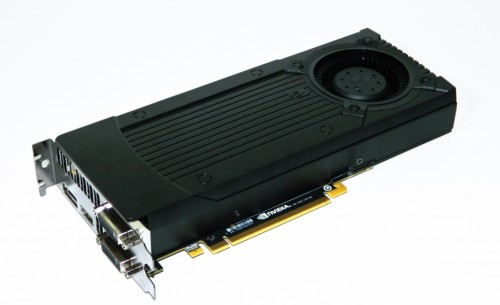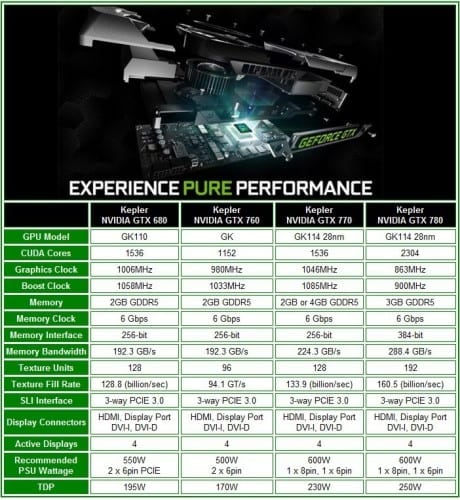The summer is upon us signaling the end of school for millions of students. And, naturally, many gaming rigs have been ignored or put on hold in search of academic excellence. This means that graphically elite new games that were released within the last year that many have been dying to play, will most likely require a video card upgrade to run. Hopefully, you have some left over cash, or are working part time to put towards this worthy investment. If you’re in search of a new video card that won’t ensure you having to eat Ramen all next year, you’re in luck. NVIDIA has just released their new GEFORCE GTX 760 video card boasting high end performance without the high end price tag.
GTX 760 features clocks speeds and features around the GTX 680 mark, but minus the price tag. With 2GB GDDR5 video memory at decent speeds, a 256-bit bus and 1152 CUDA cores, it’s one GPU that should easily bring on the eye candy without hitting unplayable frame rates in the latest triple A tites. We’ve got some new game titles test and plenty of PhysX to throw at this new card. Let’s see if the $249US NVIDIA GTX 760 is exactly what you need to last you for another couple years of gaming enjoyment.
Features and Specifications
For a quick feature recap, it’s all about the frame rates, 1080p, and 3D gaming on all the present and immediate future game engines. Unfortunately, we don’t have anything with the Unreal 3 or 4 engine. The closest thing to it are a couple of demos like “Infiltrator” we’ve seen at some of the larger gaming expos. Obviously, any of the Kepler based GTX 700 series GPUs will handle the current titles. Here’s a break down of the series as it stands in comparison to the GTX 680 which is also a Kepler based card (but at a much higher price point).
As you can see that the GTX 760 is similar to the GTX 680 in that both have a 256-bit memory interface supporting 2GB GDDR5. This is just about the most video memory ever packed on to a $299 video card. Basically, the resources of the GTX 760 are more than enough to support today’s most intense games. Granted, you’re not going to get three displays to render smooth playable frame rates, but that isn’t the goal of the card. The goal of this card is to fill that bang for buck performance spot for today’s nicer games just like the former GTX 660 Ti did when it launched at a very similar price point of around $249 USD.
Remember that any of the current GTX 6xx and 7xx cards are thoroughly supported by the GEFORCE Experience app which optimizes games for your video cards automatically. And, the latest TXAA sampling is built in to the GPUs which replaces regular anti-aliasing. The graphics should be awesome at very playable frame rates without very much tweaking. Let’s find out if the GTX 760 truly measures up.
Test System Configuration
The test system is comprised of all the same components in the previous GTX 770 and 780 reviews. The only major difference is the new 320.49 NVIDIA driver used which supports the GTX 760. The GTX 770 and 780 both use the 320.18 driver which is the current stable reference driver.
- Processor: Intel Core i7-3770K Ivy Bridge
- Motherboard: GIGABYTE Z77X-UP7 OC Edition
- Memory: Kingston HyperX 2800MHz 8GB DDR3
- Graphics 1: NVIDIA GEFORCE GTX 780
- Graphics 2: NVIDIA GEFORCE GTX 770
- Graphics 3: GIGABYTE GTX 670 OC
- Graphics 4: ZOTAC GTX 680 AMP
- Graphics 5: ASUS HD 7970 DirectCU II
- Graphics 6: EVGA GTX 660 Ti SC
- Power Supply: Rosewill 1000 Watt Tachyon Platinum
- Storage: Kingston HyperX 3K 240GB SSD
- OS: Windows 7 Pro
- CPU Cooling: Corsair H110
The display is an ASUS VG278H 3D 1080p monitor. Game settings are all maxed out to make the GPU work hardest. Frame rates were recorded with regular mode and then verified to handle 3D game settings at the end. Temperatures were monitored with EVGA’s Precision utility.
For power consumption numbers, a Seasonic Power Angel at the wall was used to determine the data. We recorded noise levels with a meter at 2 feet distance in an open and closed computer case.One final note is that the HD 7970 GPU was tested with PhysX disabled because it doesn’t support the feature. At least not officially.
Real World Gaming Performance
Assassin’s Creed III
After giving AC III a few spins on the new card, I found the game play smooth. It’s the only game in the tests that doesn’t properly support 3D gaming. None the less, there’s a lot to appreciate when you have a GTX 760 installed. It’s the TXAA smooth sampling that makes the game look so good. I think the 10-15% frame sacrifice is worth it and should be left on.
Battlefield 3
Despite all the Battlefield 3 quirks in multiplayer, the game is still quite decent in single player. Even with all the mapping, textures, moving models, and fast pasted graphics, the GTX 760 shows itself to be a capable battle card. It will no doubt do well in Battlefield 4 as well when it launches later this year.
Metro: Last Light
I wasn’t expecting the GTX 760 to perform so well here especially given how brutal Metro has been on any and every card since Metro 2033 launched. In contrast, a game like Crysis 3 has a lot more mapping to stall a GPU but Metro uses immense textures and ambiance to slap the GPUs silly. Nicely done to say the least.
Batman Arkham City
PhysX is rocked by the GTX 760, or any NVIDIA card for that matter. The card still came in just a couple frames slower than the former, more expensive GTX 670 OC. It’s obvious where the card lands performance wise.
Next we move on to synthetic benchmarks, power consumption (plus temps/noise) and bring it on home before your coffee is done!
Synthetic Benchmarks
While real world gaming benchmarks are essential, but they sometimes don’t provide the cross reference one needs to compare their own current equipment. We’ve chosen two more benchmarks that are both free and provide you a good snapshot of how this card will upgrade your experience compared to what you have right now.
3DMark11
The GTX 760 may seem like it’s not doing well but 3DMark11 puts more of the video cards’ resources to work. Naturally, the cards with the higher memory, higher memory bit rate, more shader processors, and matching frequencies outpace the GTX 760. This is still a respectable score against so many factory overclocked cards.
Heaven 3.0 Demo
With the higher detailed settings, Heaven beats just about any GPU down pretty hard. But even here, the GTX 760 keeps up with the GTX 670 OC which has better resources on tap, but a much higher price tag as well. It all seems to come down to frequency and bandwidth which is right up there on the GTX 760.
Thermal, Power, and Noise Evaluation
There are couple things that I’d like to point out about the GTX 7xx Kepler series video cards. The maximum temperature threshold seems to be 80C on all the cards. The GTX 770 and 780 gradually worked their way up close but didn’t quite reach it in previous testing. However, when they got close, the fan speeds just about doubled. They definitely doubled on the GTX 760 at just under 35dB. Even with the new fan speed stabling technology built into the software to more gradually bring up the speeds.
That said, the batch of cards all took longer to get close to 80C mainly because they all have substantial coolers. The GTX 760 has a smaller cooler that doesn’t have all the metal bits that help, plus higher frequencies, and quickly reached 80C. In other words, the card gets hot fast making me wonder if we’ll see many “overclocked” editions with a reference cooler strapped to it. When idle or working just with desktop (2D), the card idles at 31C and isn’t easily audible unless you get close. Power consumption wise, the GTX 760 drew about 166 watts overall.
Final Thoughts
After all the 3D benchmarks ended, it was apparent that the NVIDIA GTX 760 is a very serious $249 US starting price GPU. It offers all the latest NVIDIA features that should easily support any upcoming game engines in the next couple years. It’s a very nimble 2GB video card with the heart of a beefier GTX 670 (without the price tag). The card will definitely offer a noticeable jump in performance even over the already awesome GTX 660 Ti cards. Especially in the higher end games that take advantage of extremely detailed graphics and immense maps. It’s safe to say that this should be a Battlefield 4 friendly video card when the game finally launches later this year.
Some of the things that I found a little concerning is that fact that the card gets 80C hot very quickly. I would recommend buying only GTX 760 factory overclocked cards that have substantial GPU coolers especially if you live in hotter climates. Manual fan control like that available on ASUS GPU Tweak or EVGA Precision X is very helpful for cooling down the card at the top of the range.
Still, at the current starting price of $249 US, it’s only a little more than the GTX 660 when it launched. But now you get a far more capable GPU in the GTX 760 that is ready to take on future titles. If you are looking for a serious bang for buck card, I highly recommend the NVIDIA GTX 760 as your next gaming GPU at this price point.
Pros
- Best cost efficient performer
- Very good performance
- Surprisingly quiet at load
- A good 550 watt 80Plus PSU will suffice
Cons
- Gets hot quite quickly
- Requires manual fan control to stay around 75C or less
- Manual control means more noise
Overall Rating: 8.75 / 10.0
Help Us Improve Our Reviews By Leaving a Comment Below!



